浅论广告英语的语言特点
广告英语语言特点及其翻译策略
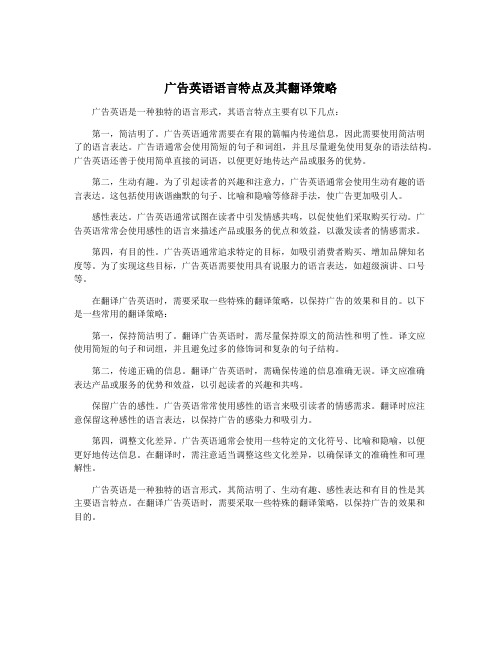
广告英语语言特点及其翻译策略广告英语是一种独特的语言形式,其语言特点主要有以下几点:第一,简洁明了。
广告英语通常需要在有限的篇幅内传递信息,因此需要使用简洁明了的语言表达。
广告语通常会使用简短的句子和词组,并且尽量避免使用复杂的语法结构。
广告英语还善于使用简单直接的词语,以便更好地传达产品或服务的优势。
第二,生动有趣。
为了引起读者的兴趣和注意力,广告英语通常会使用生动有趣的语言表达。
这包括使用诙谐幽默的句子、比喻和隐喻等修辞手法,使广告更加吸引人。
感性表达。
广告英语通常试图在读者中引发情感共鸣,以促使他们采取购买行动。
广告英语常常会使用感性的语言来描述产品或服务的优点和效益,以激发读者的情感需求。
第四,有目的性。
广告英语通常追求特定的目标,如吸引消费者购买、增加品牌知名度等。
为了实现这些目标,广告英语需要使用具有说服力的语言表达,如超级演讲、口号等。
在翻译广告英语时,需要采取一些特殊的翻译策略,以保持广告的效果和目的。
以下是一些常用的翻译策略:第一,保持简洁明了。
翻译广告英语时,需尽量保持原文的简洁性和明了性。
译文应使用简短的句子和词组,并且避免过多的修饰词和复杂的句子结构。
第二,传递正确的信息。
翻译广告英语时,需确保传递的信息准确无误。
译文应准确表达产品或服务的优势和效益,以引起读者的兴趣和共鸣。
保留广告的感性。
广告英语常常使用感性的语言来吸引读者的情感需求。
翻译时应注意保留这种感性的语言表达,以保持广告的感染力和吸引力。
第四,调整文化差异。
广告英语通常会使用一些特定的文化符号、比喻和隐喻,以便更好地传达信息。
在翻译时,需注意适当调整这些文化差异,以确保译文的准确性和可理解性。
广告英语是一种独特的语言形式,其简洁明了、生动有趣、感性表达和有目的性是其主要语言特点。
在翻译广告英语时,需要采取一些特殊的翻译策略,以保持广告的效果和目的。
广告英语语言特点及其翻译策略

广告英语语言特点及其翻译策略一、引言广告英语作为商业传媒中的一种特殊语言,其语言特点和翻译策略备受关注。
广告英语是商业宣传的重要工具,其语言特点与翻译策略的研究不仅有助于加深对广告英语的理解,也为跨文化翻译提供了有益的借鉴。
本文旨在探讨广告英语的语言特点,并就其翻译策略进行深入剖析,旨在为更好地理解广告英语的特点与翻译提供指导。
二、广告英语语言特点1. 简洁明了广告英语具有简洁明了的特点,用词简练、精准,能够迅速吸引读者或听众的注意力。
广告英语常常采用简短的句子和词组,力求表达简练,使得广告信息更加生动鲜明,容易被接受并记住。
2. 超文本性广告英语倾向于使用隐喻、比喻、排比和修辞等修辞手法,直面读者或听众内心深层需求,激发共鸣和好奇心,从而让广告信息更容易被接受、认同和记忆。
3. 制造情感共鸣广告英语善于利用情感化的表达方式,通过渲染情感和氛围,从而激发受众的情感共鸣,产生共鸣效应。
广告英语会通过描写、抒情、警句等手法营造感人的场景,使得受众更容易产生共情,从而对产品产生好感。
4. 偏向图像化广告英语常倾向于将广告信息通过图像化的手段更加直观地呈现出来。
在广告中,图像、颜色和排版布局等图像元素被广泛运用,以吸引观众的视觉关注,达到更加直接的宣传效果。
三、广告英语翻译策略1. 保持原意在翻译广告英语时,应当尽量保持广告原意和原味,以便让被翻译广告的受众容易理解和接受。
翻译应该尽量忠实于原文的表达方式和情感色彩,以确保广告信息能够得到完整有效的传达。
2. 简洁优美翻译广告英语时应保持简洁明了的原则,确保译文简洁、优美、易读。
翻译时应注意保持原广告英语的简短、生动的特点,力求用词简练、表达准确,确保达到相似的广告效果。
3. 引入地域文化元素在翻译广告英语时,需要考虑受众所处的文化环境和语言习惯,适当引入地域文化元素,使翻译结果更容易被接受和认同。
在翻译广告时,应当充分考虑受众的文化差异,避免因文化差异而造成误解或冲突。
广告英语语言特点及其翻译策略

广告英语语言特点及其翻译策略1. 引言2. 广告英语的语言特点(1) 精炼简洁:广告英语通常采用简洁明了的语言风格,力求用简洁的词语和句式来传达产品或服务的信息,吸引受众的注意力。
经典的麦当劳广告口号“i'm lovin' it”就采用了简单的词语和非正式的语法结构,但极具吸引力。
(2) 形象鲜明:广告英语在描述产品或服务特点时,常常采用形象生动的词语和比喻手法,以便让受众更加直观地感受到产品或服务的独特之处。
苹果公司的广告语“Think Different”中的“Different”一词就是一种鲜明的形象。
(3) 情感溢出:广告英语在传达产品或服务信息的往往会借助情感色彩来打动受众,引发其购买欲望。
这种情感可以是温情、幽默、激情等,不同的广告针对不同的产品或服务会有不同的情感表达手法。
(4) 引人入胜:广告英语通常采用一些引人入胜的修辞手法,比如排比、反复、对比等,来增加广告的吸引力和记忆度。
这些修辞手法可以让广告语言更加生动有趣,更容易被受众接受和记住。
3. 广告英语翻译策略(1) 准确传达原意:在翻译广告英语时,首要任务是准确传达原意。
无论是产品的特点、品牌的形象还是广告的宣传口号,都需要保持准确的翻译,以确保消费者能够理解并接受广告信息。
(2) 追求文化共鸣:由于不同国家和地区的文化差异,广告英语在翻译时需要考虑目标受众的文化背景和习惯。
翻译广告时,需要尽量追求文化共鸣,使广告信息在不同文化环境下都能引发共鸣和情感共鸣。
(3) 保持创意和趣味性:广告英语的精彩之处在于其创意和趣味性,在翻译过程中需要保持这种特点。
翻译广告时需要保持原有的创意和趣味性,不仅要准确传达信息,还要尽量保留广告原有的语言特色和风格。
(4) 语言通顺自然:广告英语常常采用一些生动、夸张和独特的语言表达方式,在翻译时需要保持语言的通顺和自然,避免生搬硬套或生硬翻译,以免丢失广告的吸引力。
(5) 选用恰当词语:在翻译广告时,需要选用恰当的词语和表达方式,以便让目标受众能够更好地理解广告信息,产生共鸣。
浅谈广告英语的语言特点
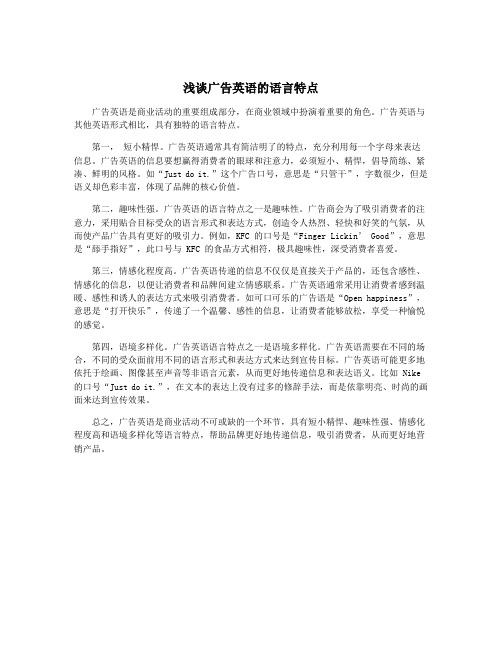
浅谈广告英语的语言特点广告英语是商业活动的重要组成部分,在商业领域中扮演着重要的角色。
广告英语与其他英语形式相比,具有独特的语言特点。
第一,短小精悍。
广告英语通常具有简洁明了的特点,充分利用每一个字母来表达信息。
广告英语的信息要想赢得消费者的眼球和注意力,必须短小、精悍,倡导简练、紧凑、鲜明的风格。
如“Just do it.”这个广告口号,意思是“只管干”,字数很少,但是语义却色彩丰富,体现了品牌的核心价值。
第二,趣味性强。
广告英语的语言特点之一是趣味性。
广告商会为了吸引消费者的注意力,采用贴合目标受众的语言形式和表达方式,创造令人热烈、轻快和好笑的气氛,从而使产品广告具有更好的吸引力。
例如,KFC 的口号是“Finger Lickin’ Good”,意思是“舔手指好”,此口号与 KFC 的食品方式相符,极具趣味性,深受消费者喜爱。
第三,情感化程度高。
广告英语传递的信息不仅仅是直接关于产品的,还包含感性、情感化的信息,以便让消费者和品牌间建立情感联系。
广告英语通常采用让消费者感到温暖、感性和诱人的表达方式来吸引消费者。
如可口可乐的广告语是“Open happiness”,意思是“打开快乐”,传递了一个温馨、感性的信息,让消费者能够放松,享受一种愉悦的感觉。
第四,语境多样化。
广告英语语言特点之一是语境多样化。
广告英语需要在不同的场合,不同的受众面前用不同的语言形式和表达方式来达到宣传目标。
广告英语可能更多地依托于绘画、图像甚至声音等非语言元素,从而更好地传递信息和表达语义。
比如 Nike 的口号“Just do it.”,在文本的表达上没有过多的修辞手法,而是依靠明亮、时尚的画面来达到宣传效果。
总之,广告英语是商业活动不可或缺的一个环节,具有短小精悍、趣味性强、情感化程度高和语境多样化等语言特点,帮助品牌更好地传递信息,吸引消费者,从而更好地营销产品。
广告英语语言特点及其翻译策略

广告英语语言特点及其翻译策略一、广告英语语言特点1. 浓缩精炼广告英语以精炼简洁著称,通过简洁、直接、富有表现力的语言,快速传达产品或服务的信息,并唤起受众的购买欲望。
在广告文本中,常出现一些简短而具有冲击力的口号和标语,例如Nike的"Just do it",可口可乐的"Open happiness"等。
2. 情感化广告英语注重情感表达,通过美学手法和情感色彩,唤起受众的共鸣和共情,引发购买欲望。
广告语言常常运用排比、修辞等修辞手法,以及美丽动人的描绘和夸张的语言来吸引受众的注意力。
3. 诱导性广告英语具有很强的诱导性,其目的是为了促使受众产生购买行为。
广告文本中常常出现一些具有现实诱惑力的词语和句子,如免费、打折、限时优惠等。
4. 社会化广告英语紧跟时代潮流,融入当下社会文化和流行趋势,通过话题热点和时尚元素来吸引受众的注意力。
广告语言也常常运用一些流行俚语和网络语言,使其更容易引起年轻受众的共鸣。
二、广告英语翻译策略1. 保持语言简洁在翻译广告英语时,应力求保持语言的简洁明了,避免翻译过于冗长,以免丧失广告文本原有的冲击力和直接性。
需要注重翻译译文的流畅性和易读性,符合目标受众的阅读习惯和接受程度。
2. 重视情感表达在翻译广告英语时,要注重情感表达,保持译文的美感和感染力,使其能够唤起目标受众的共鸣和共情。
可以通过选择恰当的修辞手法和形象描绘,使译文更具有表现力和感染力。
3. 强化诱导性翻译广告英语时,应注意强化译文的诱导性,突出产品或服务的优势和特点,引导目标受众产生购买欲望。
可以通过选择有诱惑力的词语和句子,保持译文的实用性和现实诱惑力。
4. 结合当地文化在翻译广告英语时,应该结合当地文化和流行趋势,加入适当的话题热点和时尚元素,以吸引目标受众的注意力。
需要注重调整译文的语言风格和文化内涵,使其更符合目标受众的文化背景和习惯。
5. 注重翻译质量在翻译广告英语时,需要注重翻译质量和准确性,确保译文与原文保持一致性和准确性。
广告英语的语言特点及翻译策略-范文
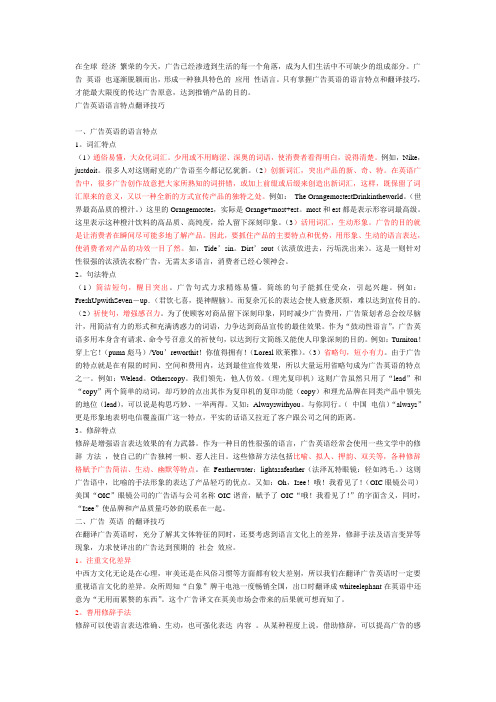
在全球经济繁荣的今天,广告已经渗透到生活的每一个角落,成为人们生活中不可缺少的组成部分。
广告英语也逐渐脱颖而出,形成一种独具特色的应用性语言。
只有掌握广告英语的语言特点和翻译技巧,才能最大限度的传达广告原意,达到推销产品的目的。
广告英语语言特点翻译技巧一、广告英语的语言特点1。
词汇特点(1)通俗易懂,大众化词汇。
少用或不用晦涩、深奥的词语,使消费者看得明白,说得清楚。
例如,Nike,justdoit。
很多人对这则耐克的广告语至今都记忆犹新。
(2)创新词汇,突出产品的新、奇、特。
在英语广告中,很多广告创作故意把大家所熟知的词拼错,或加上前缀或后缀来创造出新词汇,这样,既保留了词汇原来的意义,又以一种全新的方式宣传产品的独特之处。
例如:The OrangemostestDrinkintheworld。
(世界最高品质的橙汁。
)这里的Orangemostes,实际是Orange+most+est。
most和est都是表示形容词最高级。
这里表示这种橙汁饮料的高品质、高纯度,给人留下深刻印象。
(3)活用词汇,生动形象。
广告的目的就是让消费者在瞬间尽可能多地了解产品。
因此,要抓住产品的主要特点和优势,用形象、生动的语言表达,使消费者对产品的功效一目了然。
如,Tide’sin。
Dirt’sout(汰渍放进去,污垢洗出来)。
这是一则针对性很强的汰渍洗衣粉广告,无需太多语言,消费者已经心领神会。
2。
句法特点(1)简洁短句,醒目突出。
广告句式力求精炼易懂。
简练的句子能抓住受众,引起兴趣。
例如:FreshUpwithSeven-up.(君饮七喜,提神醒脑)。
而复杂冗长的表达会使人疲惫厌烦,难以达到宣传目的。
(2)祈使句,增强感召力。
为了使顾客对商品留下深刻印象,同时减少广告费用,广告策划者总会绞尽脑汁,用简洁有力的形式和充满诱惑力的词语,力争达到商品宣传的最佳效果。
作为“鼓动性语言”,广告英语多用本身含有请求、命令号召意义的祈使句,以达到行文简练又能使人印象深刻的目的。
广告英语的语言特点及翻译策略

广告英语的语言特点及翻译策略广告英语的语言特点广告(advertise)原于拉丁语的advertere一词,意为“唤起大众对某种事物的注意并诱导于一定的方向所使用的一种手段”。
“Advertising is the non-personal communication of information usually paid for and usually persuasive in nature about products, services or ideas by indentified sponsors through the various media.”根据这一定义,广告应具备传递信息的信息功能,诱使读者在获得信息后作出广告所期望的反应的诱导功能,以及对商品进行粉饰美化的美感功能和表情功能。
广告是一种竞争性的商业行为,目的是争取消费者,因而商业广告就是向潜在的广大消费者介绍商品,激发其对某种商品的兴趣,从而促使其购买的一种手段。
广告英语经过长期的发展,在词法、句法、修辞等方面都表现出一定的特点。
1.广告英语的词汇特点广告英语须简洁、形象、富于感染力。
因此恰当、准确的选词对广告的效力有着不可忽视的作用。
(1)简明易懂,通俗易记广告文字必须具备通俗易懂的特性,多用大众化的口语词汇,少用或不用晦涩、深奥的词语,使消费者看得明白,说得清楚。
如,Nike,just do it.(耐克,想做就做)。
再如,Scots Whisky Uncommonly smooth.(苏格兰威士忌口感滋润非同凡响)。
(2)创新拼写,增强吸引力在广告英语中,创作人员会故意把人们所熟知的词拼错,或加上前缀、后缀。
虽然新造词与原词形态不同,但意义仍存,这既可以达到生动、有趣和引人注意的目的,又可以有效地传播商品信息。
同时,人们往往认为用词富于创新的广告,其宣传的产品常具独特之处。
如,Give a Timex to all, to all a good Time. (拥有一块天美时表,拥有一段美好时光)。
浅谈广告英语的语言特点
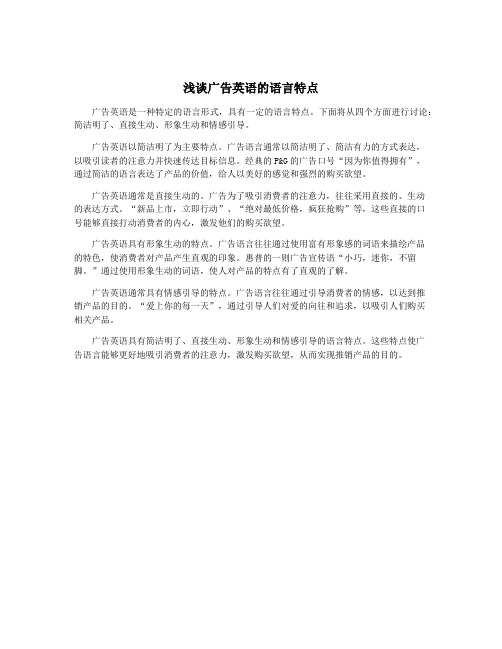
浅谈广告英语的语言特点
广告英语是一种特定的语言形式,具有一定的语言特点。
下面将从四个方面进行讨论:简洁明了、直接生动、形象生动和情感引导。
广告英语以简洁明了为主要特点。
广告语言通常以简洁明了、简洁有力的方式表达,
以吸引读者的注意力并快速传达目标信息。
经典的P&G的广告口号“因为你值得拥有”,
通过简洁的语言表达了产品的价值,给人以美好的感觉和强烈的购买欲望。
广告英语通常是直接生动的。
广告为了吸引消费者的注意力,往往采用直接的、生动
的表达方式。
“新品上市,立即行动”、“绝对最低价格,疯狂抢购”等,这些直接的口
号能够直接打动消费者的内心,激发他们的购买欲望。
广告英语具有形象生动的特点。
广告语言往往通过使用富有形象感的词语来描绘产品
的特色,使消费者对产品产生直观的印象。
惠普的一则广告宣传语“小巧,迷你,不留脚。
”通过使用形象生动的词语,使人对产品的特点有了直观的了解。
广告英语通常具有情感引导的特点。
广告语言往往通过引导消费者的情感,以达到推
销产品的目的。
“爱上你的每一天”,通过引导人们对爱的向往和追求,以吸引人们购买
相关产品。
广告英语具有简洁明了、直接生动、形象生动和情感引导的语言特点。
这些特点使广
告语言能够更好地吸引消费者的注意力,激发购买欲望,从而实现推销产品的目的。
浅谈广告英语的语言特点
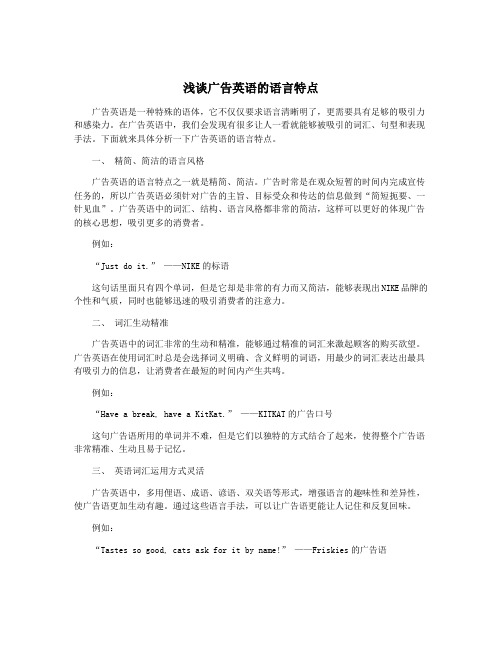
浅谈广告英语的语言特点广告英语是一种特殊的语体,它不仅仅要求语言清晰明了,更需要具有足够的吸引力和感染力。
在广告英语中,我们会发现有很多让人一看就能够被吸引的词汇、句型和表现手法。
下面就来具体分析一下广告英语的语言特点。
一、精简、简洁的语言风格广告英语的语言特点之一就是精简、简洁。
广告时常是在观众短暂的时间内完成宣传任务的,所以广告英语必须针对广告的主旨、目标受众和传达的信息做到“简短扼要、一针见血”。
广告英语中的词汇、结构、语言风格都非常的简洁,这样可以更好的体现广告的核心思想,吸引更多的消费者。
例如:“Just do it.” ——NIKE的标语这句话里面只有四个单词,但是它却是非常的有力而又简洁,能够表现出NIKE品牌的个性和气质,同时也能够迅速的吸引消费者的注意力。
二、词汇生动精准广告英语中的词汇非常的生动和精准,能够通过精准的词汇来激起顾客的购买欲望。
广告英语在使用词汇时总是会选择词义明确、含义鲜明的词语,用最少的词汇表达出最具有吸引力的信息,让消费者在最短的时间内产生共鸣。
例如:“Have a break, have a KitKat.” ——KITKAT的广告口号这句广告语所用的单词并不难,但是它们以独特的方式结合了起来,使得整个广告语非常精准、生动且易于记忆。
三、英语词汇运用方式灵活广告英语中,多用俚语、成语、谚语、双关语等形式,增强语言的趣味性和差异性,使广告语更加生动有趣。
通过这些语言手法,可以让广告语更能让人记住和反复回味。
例如:“Tastes so good, cats ask for it by name!” ——Friskies的广告语这句广告语采用双关语的方式激发了消费者的笑点,并且能够让受众对该产品印象深刻,在消费者选择宠物食品时对公司的产品更有信心。
四、感性、直观的句式广告英语中可以使用很多感性、直观的句式,比如反问句、定语从句、主动语态等等。
这些句式能够给受众留下深刻的印象和感动,让消费者深刻认识到自己需要这种产品。
广告英语语言特点及其翻译策略
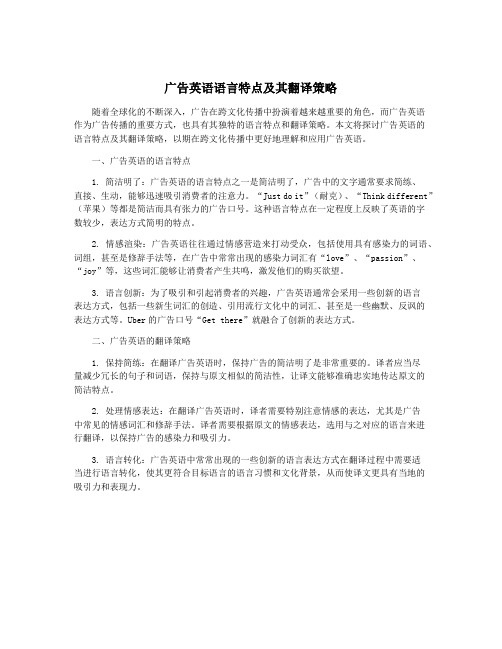
广告英语语言特点及其翻译策略随着全球化的不断深入,广告在跨文化传播中扮演着越来越重要的角色,而广告英语作为广告传播的重要方式,也具有其独特的语言特点和翻译策略。
本文将探讨广告英语的语言特点及其翻译策略,以期在跨文化传播中更好地理解和应用广告英语。
一、广告英语的语言特点1. 简洁明了:广告英语的语言特点之一是简洁明了,广告中的文字通常要求简练、直接、生动,能够迅速吸引消费者的注意力。
“Just do it”(耐克)、“Think different”(苹果)等都是简洁而具有张力的广告口号。
这种语言特点在一定程度上反映了英语的字数较少,表达方式简明的特点。
2. 情感渲染:广告英语往往通过情感营造来打动受众,包括使用具有感染力的词语、词组,甚至是修辞手法等,在广告中常常出现的感染力词汇有“love”、“passion”、“joy”等,这些词汇能够让消费者产生共鸣,激发他们的购买欲望。
3. 语言创新:为了吸引和引起消费者的兴趣,广告英语通常会采用一些创新的语言表达方式,包括一些新生词汇的创造、引用流行文化中的词汇、甚至是一些幽默、反讽的表达方式等。
Uber的广告口号“Get there”就融合了创新的表达方式。
二、广告英语的翻译策略1. 保持简练:在翻译广告英语时,保持广告的简洁明了是非常重要的。
译者应当尽量减少冗长的句子和词语,保持与原文相似的简洁性,让译文能够准确忠实地传达原文的简洁特点。
2. 处理情感表达:在翻译广告英语时,译者需要特别注意情感的表达,尤其是广告中常见的情感词汇和修辞手法。
译者需要根据原文的情感表达,选用与之对应的语言来进行翻译,以保持广告的感染力和吸引力。
3. 语言转化:广告英语中常常出现的一些创新的语言表达方式在翻译过程中需要适当进行语言转化,使其更符合目标语言的语言习惯和文化背景,从而使译文更具有当地的吸引力和表现力。
广告英语语言特点及其翻译策略

广告英语语言特点及其翻译策略一、广告语言的特点1. 简洁性广告语言以简练、紧凑为主要特点,力求用最少的词语表达最丰富的信息。
广告语言中的每一个词语都具有重要的意义,没有多余的修饰和废话。
广告语言还倾向于使用简单易懂的词语和句子结构,让受众能够迅速理解广告内容。
2. 生动性广告语言也具有生动性,它能够通过形象、比喻、排比等修辞手法,抓住受众的注意力,让受众产生强烈的联想和感受。
生动的广告语言往往能够激发受众的购买欲望,从而达到广告宣传的目的。
3. 具有感染力广告语言追求感染力,通过积极的词语和情感化的表达方式,来呼吁受众对产品或服务产生兴趣和好感。
广告语言往往具有较强的情感色彩,能够引起受众共鸣,从而使广告内容更加深入人心。
二、广告英语语言翻译策略1. 保持原意和效果翻译广告语言的首要任务是保持其原意和效果。
在翻译过程中,翻译人员需要尽量忠实地传达原文的意思和情感,避免过度添加解释性的文字,从而保持广告的感染力和吸引力。
2. 注意文化差异在翻译广告语言时,需要充分考虑不同文化背景下的语言环境和习惯,避免出现因文化差异导致的误解或冲突。
翻译人员需要了解目标受众所处的文化环境,选择合适的词语和表达方式,以便让广告内容更好地融入目标市场。
3. 灵活运用翻译手段翻译广告语言时,需要灵活运用翻译手段,包括意译、调整语序、选择对等语言现象等,以便更好地传达原文的情感和效果。
翻译人员还可以借助音韵美、节奏感等语言特点,来增强翻译的吸引力和感染力。
4. 避免字面翻译广告语言往往具有很强的个性化和创意性,因此在翻译过程中需要避免简单的字面翻译,而要根据广告的特点和目的,来进行自由、灵活的翻译。
翻译人员可以在保持原意的基础上,注重表达方式和语言效果,使翻译后的广告语言更加贴近受众。
5. 反复斟酌和核对翻译广告语言是一项非常严谨的工作,翻译人员需要反复斟酌和核对每一个词语和表达,确保翻译后的广告语言能够完整地传达原文的意思和感染力。
浅论广告英语的语言特点
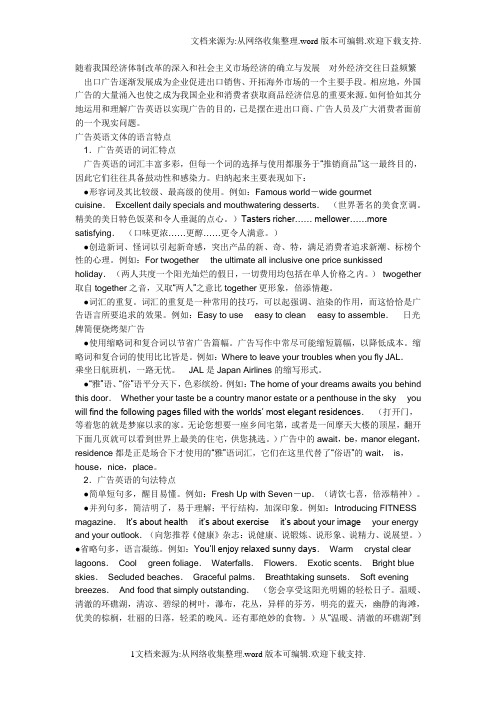
随着我国经济体制改革的深入和社会主义市场经济的确立与发展对外经济交往日益频繁出口广告逐渐发展成为企业促进出口销售、开拓海外市场的一个主要手段。
相应地,外国广告的大量涌入也使之成为我国企业和消费者获取商品经济信息的重要来源。
如何恰如其分地运用和理解广告英语以实现广告的目的,已是摆在进出口商、广告人员及广大消费者面前的一个现实问题。
广告英语文体的语言特点1.广告英语的词汇特点广告英语的词汇丰富多彩,但每一个词的选择与使用都服务于“推销商品”这一最终目的,因此它们往往具备鼓动性和感染力。
归纳起来主要表现如下:●形容词及其比较级、最高级的使用。
例如:Famous world-wide gourmet cuisine.Excellent daily specials and mouthwatering desserts.(世界著名的美食烹调。
精美的美日特色饭菜和令人垂涎的点心。
)Tasters richer…… mellower……more satisfying.(口味更浓……更醇……更令人满意。
)●创造新词、怪词以引起新奇感,突出产品的新、奇、特,满足消费者追求新潮、标榜个性的心理。
例如:For twogether the ultimate all inclusive one price sunkissed holiday.(两人共度一个阳光灿烂的假日,一切费用均包括在单人价格之内。
)twogether 取自together之音,又取“两人”之意比together更形象,倍添情趣。
●词汇的重复。
词汇的重复是一种常用的技巧,可以起强调、渲染的作用,而这恰恰是广告语言所要追求的效果。
例如:Easy to use easy to clean easy to assemble.日光牌简便烧烤架广告●使用缩略词和复合词以节省广告篇幅。
广告写作中常尽可能缩短篇幅,以降低成本。
缩略词和复合词的使用比比皆是。
例如:Where to leave your troubles when you fly JAL.乘坐日航班机,一路无忧。
浅谈广告英语的语言特点
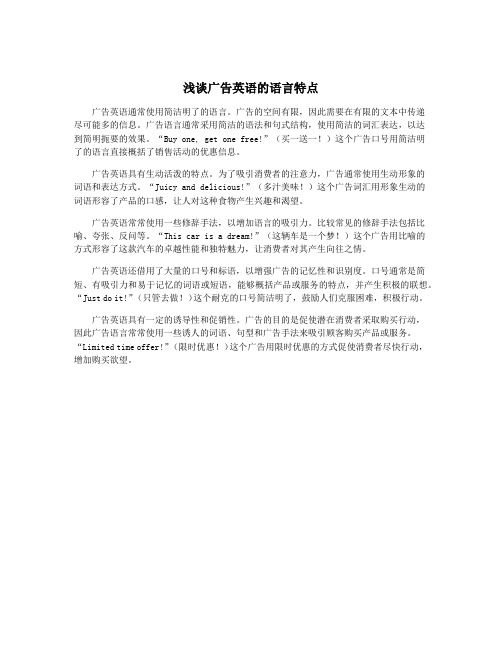
浅谈广告英语的语言特点
广告英语通常使用简洁明了的语言。
广告的空间有限,因此需要在有限的文本中传递
尽可能多的信息。
广告语言通常采用简洁的语法和句式结构,使用简洁的词汇表达,以达
到简明扼要的效果。
“Buy one, get one free!”(买一送一!)这个广告口号用简洁明
了的语言直接概括了销售活动的优惠信息。
广告英语具有生动活泼的特点。
为了吸引消费者的注意力,广告通常使用生动形象的
词语和表达方式。
“Juicy and delicious!”(多汁美味!)这个广告词汇用形象生动的
词语形容了产品的口感,让人对这种食物产生兴趣和渴望。
广告英语常常使用一些修辞手法,以增加语言的吸引力。
比较常见的修辞手法包括比喻、夸张、反问等。
“This car is a dream!”(这辆车是一个梦!)这个广告用比喻的
方式形容了这款汽车的卓越性能和独特魅力,让消费者对其产生向往之情。
广告英语还借用了大量的口号和标语,以增强广告的记忆性和识别度。
口号通常是简短、有吸引力和易于记忆的词语或短语,能够概括产品或服务的特点,并产生积极的联想。
“Just do it!”(只管去做!)这个耐克的口号简洁明了,鼓励人们克服困难,积极行动。
广告英语具有一定的诱导性和促销性。
广告的目的是促使潜在消费者采取购买行动,
因此广告语言常常使用一些诱人的词语、句型和广告手法来吸引顾客购买产品或服务。
“Limited time offer!”(限时优惠!)这个广告用限时优惠的方式促使消费者尽快行动,增加购买欲望。
浅谈广告英语的语言特点
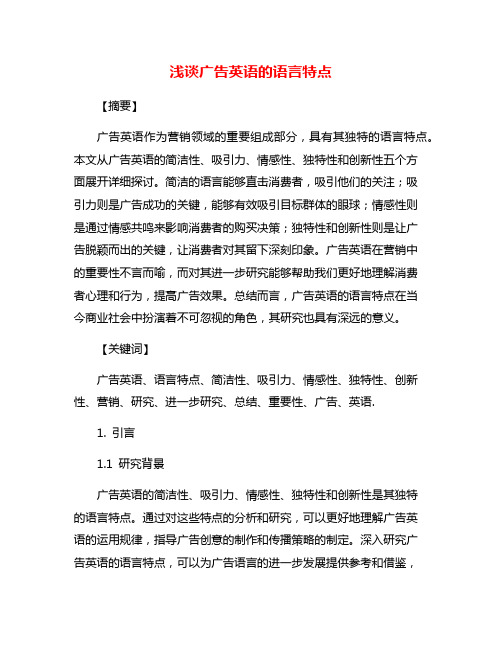
浅谈广告英语的语言特点【摘要】广告英语作为营销领域的重要组成部分,具有其独特的语言特点。
本文从广告英语的简洁性、吸引力、情感性、独特性和创新性五个方面展开详细探讨。
简洁的语言能够直击消费者,吸引他们的关注;吸引力则是广告成功的关键,能够有效吸引目标群体的眼球;情感性则是通过情感共鸣来影响消费者的购买决策;独特性和创新性则是让广告脱颖而出的关键,让消费者对其留下深刻印象。
广告英语在营销中的重要性不言而喻,而对其进一步研究能够帮助我们更好地理解消费者心理和行为,提高广告效果。
总结而言,广告英语的语言特点在当今商业社会中扮演着不可忽视的角色,其研究也具有深远的意义。
【关键词】广告英语、语言特点、简洁性、吸引力、情感性、独特性、创新性、营销、研究、进一步研究、总结、重要性、广告、英语.1. 引言1.1 研究背景广告英语的简洁性、吸引力、情感性、独特性和创新性是其独特的语言特点。
通过对这些特点的分析和研究,可以更好地理解广告英语的运用规律,指导广告创意的制作和传播策略的制定。
深入研究广告英语的语言特点,可以为广告语言的进一步发展提供参考和借鉴,促进广告行业的不断创新和发展。
本文旨在探讨广告英语的语言特点,揭示其在广告传播中的重要作用,并展望未来对广告英语的进一步研究方向。
1.2 研究目的研究目的是为了深入探讨广告英语的语言特点,分析其在广告营销中的重要作用,揭示其对消费者的影响力和吸引力。
通过研究广告英语的简洁性、吸引力、情感性、独特性和创新性,可以更好地了解广告语言的运用技巧和特色,为广告从业人员提供有效的营销策略和方法,为消费者提供更具吸引力和感染力的广告内容,从而促进商品的销售和品牌的传播。
通过对广告英语的深入研究,可以为未来的广告语言创作和营销策略提供新的思路和方向,同时也有助于提高消费者对广告的理解和接受程度,增强广告的传播效果和影响力。
本研究旨在全面分析广告英语的语言特点,揭示其对广告营销的重要意义,为广告语言的创新和发展提供理论支持和实践指导。
浅谈广告英语的语言特点

浅谈广告英语的语言特点
广告英语是商业广告中使用的一种语言,它具有以下的几个语言特点。
首先,广告英语具有极强的目的性。
广告英语是一种有目的的语言,它的主要目的就是要激发消费者购买产品或服务,因此,广告英语在语言表达上都尽可能地简短明了,让人容易理解和接受,同时也非常具有吸引力和感染力,能够吸引消费者的注意力,引发他们的兴趣和购买欲望。
其次,广告英语的语言表达具有强烈的感性色彩。
广告英语注重消费者的感官体验,使用大量的形象化、感性化的表达方式,将产品或服务赋予了新的美好形象,激发人们的感性需求和购买欲。
在广告英语中,常常使用各种修辞手法,如比喻、拟人、夸张、反复等,使产品或服务显得更具魅力和吸引力。
第三,广告英语的语言表达非常具有创意性和多样性。
广告英语的使用者通常是广告公司或企业,为了让自己的广告更能引人入胜,他们需要使用创意性强、多样性大的语言表达方式。
因此,广告英语中常常出现一些新奇、有趣、富有创意的语言表达,这些语言表达能够让广告更加生动有趣,更具吸引力。
最后,广告英语的语言表达还会结合具体的社会文化背景和时代特色。
不同的时代和不同的社会环境下,广告英语会采用不同的语言表达方式,以适应当时人们的感官需求和审美标准。
在现代社会中,一些新的信息与通讯技术被广泛应用于广告英语中,如视频、音频等多媒体技术,极大地丰富了广告的语言表达和表现形式。
综上所述,广告英语是商业广告中非常重要的语言形式,它既具有强烈的目的性,也非常注重感性体验,在语言表达上具有创意性和多样性,同时,也会受到当时社会文化背景和时代特色的影响。
广告英语语言特点及其翻译策略
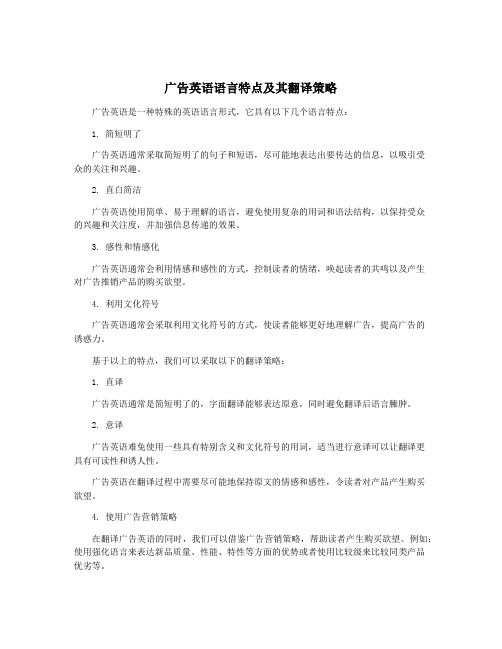
广告英语语言特点及其翻译策略
广告英语是一种特殊的英语语言形式,它具有以下几个语言特点:
1. 简短明了
广告英语通常采取简短明了的句子和短语,尽可能地表达出要传达的信息,以吸引受
众的关注和兴趣。
2. 直白简洁
广告英语使用简单、易于理解的语言,避免使用复杂的用词和语法结构,以保持受众
的兴趣和关注度,并加强信息传递的效果。
3. 感性和情感化
广告英语通常会利用情感和感性的方式,控制读者的情绪,唤起读者的共鸣以及产生
对广告推销产品的购买欲望。
4. 利用文化符号
广告英语通常会采取利用文化符号的方式,使读者能够更好地理解广告,提高广告的
诱惑力。
基于以上的特点,我们可以采取以下的翻译策略:
1. 直译
广告英语通常是简短明了的,字面翻译能够表达原意,同时避免翻译后语言臃肿。
2. 意译
广告英语难免使用一些具有特别含义和文化符号的用词,适当进行意译可以让翻译更
具有可读性和诱人性。
广告英语在翻译过程中需要尽可能地保持原文的情感和感性,令读者对产品产生购买
欲望。
4. 使用广告营销策略
在翻译广告英语的同时,我们可以借鉴广告营销策略,帮助读者产生购买欲望。
例如:使用强化语言来表达新品质量、性能、特性等方面的优势或者使用比较级来比较同类产品
优劣等。
总之,翻译广告英语需要保证翻译的可读性、可理解性和诱人性,在翻译的过程中,我们需要灵活应用不同的翻译策略,使译文更加优美、精准、准确地表达广告的宣传目的和产品特点。
广告英语语言特点及其翻译策略

广告英语语言特点及其翻译策略
广告英语是一种使用广告语言形式的英语,其目的是通过精炼而有吸引力的语言表达
来推销产品或服务。
广告英语通常具有以下特点:
1. 简明扼要:广告英语语言简洁明了,通常使用简洁的词汇和短句,以便让读者或
听众迅速理解广告内容。
2. 诱人吸引:广告英语寻求通过各种手段吸引人们的注意力,例如使用生动且有趣
的描述,或者使用夸张和诱人的词汇,以激发人们的购买欲望。
3. 强调特点:广告英语通常会强调产品或服务的特点和优势,以突出其与竞争对手
的差异化。
4. 利用感情:广告英语常常利用情感因素来吸引目标受众,通过触动人们的情感和
价值观念来提高产品的吸引力。
在翻译广告英语时,需要注意以下策略:
1. 保持简洁明了:在翻译广告英语时,要确保语言简洁明了,与原文一致。
绝对不
能因为过度翻译而导致广告内容的冗长和混乱。
2. 保留诱人性质:广告英语的吸引力在于其精炼而有吸引力的语言表达,翻译时要
尽量保留这种诱人性质,以确保目标受众的阅读或听取体验一致。
3. 突出特点和优势:在翻译广告英语时,要充分理解产品或服务的特点和优势,并
找到相应的表达方式来传达这些信息。
这可以通过使用恰当的形容词、副词和比喻等手法
来实现。
4. 理解目标受众:在翻译广告英语时,要充分理解目标受众的文化背景和价值观念,并相应地调整语言和表达方式。
这可以帮助确保广告内容更好地吸引和引起目标受众的共鸣。
翻译广告英语需要保持原文的简洁明了和吸引力,同时要理解产品或服务的特点和目
标受众的文化背景,以找到恰当的表达方式来传达广告的信息。
广告英语语言特点及其翻译策略
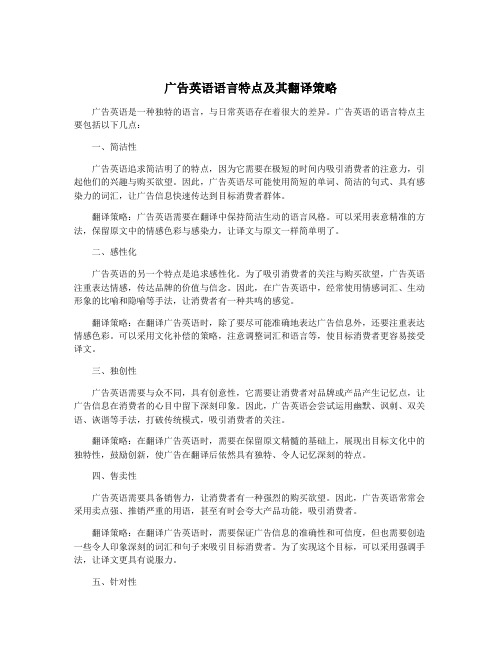
广告英语语言特点及其翻译策略广告英语是一种独特的语言,与日常英语存在着很大的差异。
广告英语的语言特点主要包括以下几点:一、简洁性广告英语追求简洁明了的特点,因为它需要在极短的时间内吸引消费者的注意力,引起他们的兴趣与购买欲望。
因此,广告英语尽可能使用简短的单词、简洁的句式、具有感染力的词汇,让广告信息快速传达到目标消费者群体。
翻译策略:广告英语需要在翻译中保持简洁生动的语言风格。
可以采用表意精准的方法,保留原文中的情感色彩与感染力,让译文与原文一样简单明了。
二、感性化广告英语的另一个特点是追求感性化。
为了吸引消费者的关注与购买欲望,广告英语注重表达情感,传达品牌的价值与信念。
因此,在广告英语中,经常使用情感词汇、生动形象的比喻和隐喻等手法,让消费者有一种共鸣的感觉。
翻译策略:在翻译广告英语时,除了要尽可能准确地表达广告信息外,还要注重表达情感色彩。
可以采用文化补偿的策略,注意调整词汇和语言等,使目标消费者更容易接受译文。
三、独创性广告英语需要与众不同,具有创意性,它需要让消费者对品牌或产品产生记忆点,让广告信息在消费者的心目中留下深刻印象。
因此,广告英语会尝试运用幽默、讽刺、双关语、诙谐等手法,打破传统模式,吸引消费者的关注。
翻译策略:在翻译广告英语时,需要在保留原文精髓的基础上,展现出目标文化中的独特性,鼓励创新,使广告在翻译后依然具有独特、令人记忆深刻的特点。
四、售卖性广告英语需要具备销售力,让消费者有一种强烈的购买欲望。
因此,广告英语常常会采用卖点强、推销严重的用语,甚至有时会夸大产品功能,吸引消费者。
翻译策略:在翻译广告英语时,需要保证广告信息的准确性和可信度,但也需要创造一些令人印象深刻的词汇和句子来吸引目标消费者。
为了实现这个目标,可以采用强调手法,让译文更具有说服力。
五、针对性广告英语需要具备针对性,获得目标消费者的认可和喜好。
因此,广告英语会研究目标消费者的社会文化背景、消费心理特点、生活习惯等信息,并针对性地进行广告宣传。
- 1、下载文档前请自行甄别文档内容的完整性,平台不提供额外的编辑、内容补充、找答案等附加服务。
- 2、"仅部分预览"的文档,不可在线预览部分如存在完整性等问题,可反馈申请退款(可完整预览的文档不适用该条件!)。
- 3、如文档侵犯您的权益,请联系客服反馈,我们会尽快为您处理(人工客服工作时间:9:00-18:30)。
随着我国经济体制改革的深入和社会主义市场经济的确立与发展对外经济交往日益频繁出口广告逐渐发展成为企业促进出口销售、开拓海外市场的一个主要手段。
相应地,外国广告的大量涌入也使之成为我国企业和消费者获取商品经济信息的重要来源。
如何恰如其分地运用和理解广告英语以实现广告的目的,已是摆在进出口商、广告人员及广大消费者面前的一个现实问题。
广告英语文体的语言特点1.广告英语的词汇特点广告英语的词汇丰富多彩,但每一个词的选择与使用都服务于“推销商品”这一最终目的,因此它们往往具备鼓动性和感染力。
归纳起来主要表现如下:●形容词及其比较级、最高级的使用。
例如:Famous world-wide gourmet cuisine.Excellent daily specials and mouthwatering desserts.(世界著名的美食烹调。
精美的美日特色饭菜和令人垂涎的点心。
)Tasters richer…… mellower……more satisfying.(口味更浓……更醇……更令人满意。
)●创造新词、怪词以引起新奇感,突出产品的新、奇、特,满足消费者追求新潮、标榜个性的心理。
例如:For twogether the ultimate all inclusive one price sunkissed holiday.(两人共度一个阳光灿烂的假日,一切费用均包括在单人价格之内。
)twogether 取自together之音,又取“两人”之意比together更形象,倍添情趣。
●词汇的重复。
词汇的重复是一种常用的技巧,可以起强调、渲染的作用,而这恰恰是广告语言所要追求的效果。
例如:Easy to use easy to clean easy to assemble.日光牌简便烧烤架广告●使用缩略词和复合词以节省广告篇幅。
广告写作中常尽可能缩短篇幅,以降低成本。
缩略词和复合词的使用比比皆是。
例如:Where to leave your troubles when you fly JAL.乘坐日航班机,一路无忧。
JAL是Japan Airlines的缩写形式。
●“雅”语、“俗”语平分天下,色彩缤纷。
例如:The home of your dreams awaits you behind this door.Whether your taste be a country manor estate or a penthouse in the sky you will find the following pages filled with the worlds’ most elegant residences.(打开门,等着您的就是梦寐以求的家。
无论您想要一座乡间宅第,或者是一间摩天大楼的顶屋,翻开下面几页就可以看到世界上最美的住宅,供您挑选。
)广告中的await,be,manor elegant,residence都是正是场合下才使用的“雅”语词汇,它们在这里代替了“俗语”的wait,is,house,nice,place。
2.广告英语的句法特点●简单短句多,醒目易懂。
例如:Fresh Up with Seven-up.(请饮七喜,倍添精神)。
●并列句多,简洁明了,易于理解;平行结构,加深印象。
例如:Introducing FITNESS magazine.It’s about health it’s about exercise it’s about your image your energy and your outlook.(向您推荐《健康》杂志:说健康、说锻炼、说形象、说精力、说展望。
)●省略句多,语言凝练。
例如:You’ll enjoy relaxed sunny days.Warm crystal clear lagoons.Cool green foliage.Waterfalls.Flowers.Exotic scents.Bright blue skies.Secluded beaches.Graceful palms.Breathtaking sunsets.Soft evening breezes.And food that simply outstanding.(您会享受这阳光明媚的轻松日子。
温暖、清澈的环礁湖,清凉、碧绿的树叶,瀑布,花丛,异样的芬芳,明亮的蓝天,幽静的海滩,优美的棕榈,壮丽的日落,轻柔的晚风。
还有那绝妙的食物。
)从“温暖、清澈的环礁湖”到“轻柔的晚风”,一连串名词短语代替了You’ll enjoy……的句子。
不仅简洁紧凑,而且又鲜明有力。
●祈使句多,具有强烈的鼓动色彩。
例如:So come into McDon ald’s and enjoy big Mac Sandwich.(走进麦当劳,享用大三明治。
)●否定句少。
即使使用否定句,也是为了用其他商品来反衬,或从反面突出产品特性。
例如:We would never say the new Audi A4 is the best in its class.We don’t have to.(我们根本不必说新型奥迪A4同类车中最好的。
没有这个必要。
)●常用主动语态和现在时,给人一种直接感,并暗示商品的持久和永恒特性。
例如:Harmony of style and performance set this new Mazda 6 a part.Qualities are at the heart of every Mazda.(式样与性能的协调一致使新型马自达6与众不同。
质量是马自达的核心。
)3.广告英语的修辞特点有人称其为“半文学体”(sub-literarygenre)(Leech,1969),因此广告中常使用修辞手段。
●比喻(analogy):Featherwater:light as a feather.(法泽瓦特眼镜:轻如鸿毛。
)●拟人(personification):Flowers by Interflora speak from the heart.(植物园培育的鲜花倾诉衷肠。
)●双关(pun):Ask for More.(摩尔牌香烟的广告)●押韵(rhyming):Hi-fi Hi-fun Hi-fashion only from Sony.(高保真,高乐趣,高时尚,只来自索尼。
)(索尼音响的广告)●重复(repetition):Dish after dish after dish.People expect us to be better.(一盘一盘又一盘。
人们盼望我们更好。
)浅论广告英语的语言特点摘要广告,顾名思义就是广而告之。
作为一种宣传和传播模式,广告的作用不容忽视,因为它不仅只是一种说服顾客进行消费的技巧,更重要的是,它已逐渐成为社会交流的必须手段之一。
本文通过对大量英语广告实例进行分析,并参照国外着名广告人Guy Cook等的理论,详细剖析了广告的语言特点。
广告在我们今天的社会几乎是无孔不入,它的传播介质多种多样,包括报纸、杂志、电视、广播、网络等。
广告具有鲜明的目的性,即说服顾客进行购买,这种目的性决定了其语言的特色性风格,使其独立于其它文体,在语言学范畴内值得研究。
本文选定这一全球普遍使用的语言,就其应用于广告领域而产生的一些语言学特点和广告本身的社会性特点进行深入分析,希望能对相关领域的研究有一定的借鉴作用和参考价值。
本文共分为五章,第一章追溯了广告的起源,对广告的分类、作用及定义做了简单概要;第二章介绍了广告和文体学的基本定义,广告中,文字和图像的完美结合取决于创意和所用媒体,但它们共同组成了广告语言;第三章从句法学、修辞学、词汇学等理论切入,用大量例子分析了广告英语的语言特点,并从语篇分析的角度对其语言特点进行了剖析;在语篇分析的章节中,引用了Guy Cook的语篇分析模型,并引入了广告问题研究领域新近提出的"文章关联性"等概念;第四章结合了第三章的观点,通过具体英语广告实例对标题中的用词、句子结构、称谓模式、修辞格进行了阐述,分析了广告语言对广告效果的影响;最后一章指出了广告发展的口语化和简单化趋势及其目前存在的模糊性语言特点,揭开了广告华丽词藻下所掩盖的非真实的广告氛围,批判了其模糊性误导消费者的消极一面。
关键词:广告;广告;语言特点AbstractAs a way of propagating and transmitting information, advertising's role connot be underestimated because it is not only an artful technique in persuading people to buy, but also gradually has become a must for social communication which in turn influences the development of society and economy. The purpose of this paper is to study the linguistic features and sociological features of advertising English, in the hope to help copywriters at home markets in their creating process.Nowadays advertising has penetrated into every corner of our life as its transmitting media in many forms: newspaper, magazine, TV, radio as well as network. The goal of advertising decides its language to be simple and direct, distinct from the characteristics of other discourses. Thus an analysis on the linguistic features of advertising English in the linguistic field is worthwhile. Under such circumstances, a study on the linguistic features of advertising English will have practical effects on the composing and translating work of the copywriters.The whole paper is divided into five chapters. The first chapter traces back the origin of advertising and a brief introduction on the classifications, roles and definitions of advertising is presented for the later discussion.The second chapter introduces the theory of advertisements and stylistics, the precise balance of words (either spoken or written) and pictures is determined by the creative concept and the medium used, but the combination of images andwords makes up the language of advertising.The third chapter starts from the theories in syntax, lexicology, rhetoric and ends with the linguistic features analyzed in the field of discourse analysis.The fourth chapter combines the viewpoints from the previous chapter third and explores the effect of the advertising English as a whole advertising process. The last chapter, also the conclusion part, shows that though advertising language appears to be flowery and refined, its content is no better than commonest language could convey. By exposing the various techniques advertisers have employed in their writing, this part hopes to remind consumers that advertising English is gradually attaining the negative and ambiguous role in guiding people to buy.Keywords: Advertising, Advertising English, Linguistic FeaturesChapter 1 IntroductionNo other statement could have summed up the charm of advertisement than what Aldous Huxley has commented. As he has said advertisement as a literary form is the most exciting, the most arduous literary form of all, and the most pregnant in curious possibilities. In his comment he asserted advertisement is a literary form and the copywriting process is the delightful and salubrious exercise for the mind. But all in all, what is advertising, and what makes it unique?1.1 History of AdvertisementAdvertisement emerged from the womb of commodity production and exchange. The condition for the existence of advertising is "at least a segment ofthe population must live above the subsistence level". When this situation occurs it also becomes necessary for "the producers of materially 'unnecessary' goods to do something to make people want to acquire their commodities." (Vestergaard and Schroder 4)The embryonic form of advertising in the world is street cries, which exist even today. Advertising was not unknown in ancient Greece and Rome, but advertising as we recognize it did not start until the seventeenth century in the West. It was at about this time that newspaper began to circulate. Before that, it is printing which was first invented in China and then introduced to the West that played a vital role in the production of print advertising. "Classified" (small ads) types of advertising were dominant before the nineteenth century and style and language used in ads at that time tended to be direct and informative. The industrial Revolution, which began in England in the mid-1700s and reached the United States by the early 1800s, facilitated mass-production of goods. Meanwhile advertising became more and more important in the industrial market. The great breakthrough for advertising came only in the late nineteenth century. Technology and mass-production techniques were then sufficiently developed for more firms to be able to turn out products of roughly the same quality and at roughly the same price. This brought on a crisis of over-production and under consumption which meant that the market needed to be stimulated by advertising. At this time advertising changed its function from proclamation to persuasion. In the twentieth century, advertising developed rapidly alongside the advent of new media-radioand television in succession.According to Richard Pollay's content analysis of two thousand print ads from ten leading magazines in the USA, ads have progressively turned towards the emotional rather than the informative approach and there is a shift seeing human nature as rational to seeming it as emotional.Today in China, while our economic structure is shifting from the entirely planned economy to the socialist market economy system, advertising is becoming more and more active and sophisticated. In 1992, China's advertising expenditure reached $ 862 million, among the fastest growing countries in Asia. This year with the entry of China into WTO, this expenditure figure will undoubtedly rise up, which will support the view that advertising is an indispensable means for providing the information that all market-oriented industrialized societies need for their economies to function efficiently.1.2 Classifications of AdvertisingAdvertising may be classified by medium (newspaper, magazine, radio, television). By target audience (consumer, industrial, business), by geography (international, national, regional, local), or by its function or purpose (product or non-product, commercial or noncommercial, primary demand or selective demand, direct action or indirect action).Because it is difficult to gain access to enough date for English commercials and ads on radio or TV, thus, the subject of this research paper will mainly concentrate on the print advertising.1.3 Roles of AdvertisingAn advertiser's main purpose is to present and exhibit product or service, and to spread the influence and coverage of which to the extent that the potential purchasing population becomes real and actual. Simply put, advertisers try by the various means at their disposal to get people to buy the product or service advertised. Moreover, advertisers want potential purchasers to consider what is advertised to the exclusion of all other similar products or services. They therefore attempt to construct an advertisement that will fully involve the attention of the potential purchaser and which will have a persuasive effect. Advertisers thus create a semiotic world in order to persuade their audience of essential "rightness" of purchasing the product or service advertised.1.4 Definitions of AdvertisingAfter a brief introduction of the classifications and roles of advertising, we now come to the definitions of advertising. From different perspectives or purposes, the definitions might also vary. In English, the word "advertise" has its origin in "advertere" in Latin, meaning "to inform somebody of something", "to bring into notice" or "to draw attention to something", etc. In Chinese, the equivalent term "guanggao" means "widely announce".The father of modern advertising, Albert Lasker said that advertising was "salesmanship in print". Although the definition was given long before the advent of radio and television, and the nature and scope of advertising at that time were considerably different than they are today, this often-repeated saying indicatesthat the ultimate objective of advertising is to sell. Obviously it is not a working definition because we cannot use it to cover all advertisements. Today, a widely quoted working definition of advertising was put forward by Courtland L. Bovee and William F. Arens :" Advertising is the nonpersonal communication of information, usually paid for and usually persuasive in nature, about products (goods or services) or ideas by identified sponsors through various media."(Cook,Guy. The Discourse of Advertising. London: Routledge,1992) Another linguist Bolen defines advertising as a "Paid, non-personal communication through various mass media by business firms, nonprofit organizations, and individuals who are in some way identified in the message and who hope to inform or persuade members of a particular audience." (Carter, Ronald and Goddard, Angela, Reah Danuta et al. Working with Texts. London: Routledge,1997)If the definitions of advertising were too vague and abstract to comprehend, a few words of its function would help to clarify this crucial term. Broadly speaking, advertisements have at least one of two functions: informing or persuading, although overlap may often take place in one single piece. The trick here is that an informative advertisement informs "the customer about goods, services, or ideas and then tells how to get them means of an identified sponsor" (Bolen 6). Examples of informative advertisements are not a few, ranging from flyers to insertions in magazine and newspapers, all of that aim to advertise new products/services or special prices on certain products/services. This type ofadvertisement gives basic, factual information and sometimes shows a photos or an illustration of the product/service to give the target audience a better view about the advertised product.Persuasive advertisements are thus the instruments used by advertisers "who have defined their target audiences and determined the effect they hope to achieve through persuasive advertisements in the media" (Bolen 9). And a persuasive advertisement should try to persuade the potential customers to buy the new product. (Bolen 6) The persuasive function is not only limited to attracting the potential customer into buying a certain object, but also including the selling of services, ideas, norms and values.To summarize, we would get the idea that firstly advertising is a communication process. Secondly, at least a medium is used. Thirdly, this communication process has a definite purpose to convince the target audience. The above three characteristics suggest advertising is closely connected with the society, employing its media, interconnecting with its people and guiding their buying habit. Also in achieving the advertising effect, the advertising language should be vivid and attractive, whose linguistic characteristics would be covered in the Chapter 3.Chapter 2 Theoretical Background2.1 Advertisement2.1.1 Definition and GoalAdvertising is the paid, impersonal communication of information aboutproducts or ideas by an identified sponsor through mass media in an effort to persuade or influence behavior. Not all advertising is alike. Advertisements differ depending on who the message is intended for, where the advertisement is shown, which media are used, and what the advertiser wants to accomplish.(see Table 2.1) Table 2.1Advertising can be classified in four ways: by target, geographic area, media used, and purpose.By Target By Geographic Area By Media Used By PurposeAudienceConsumerBusiness: Industrial Trade Professional Agriculture InternationalNationalRegionalLocal Print: Newspaper MagazineElectronic: Radio Television InternetOut-of-home: Outdoor Transit Direct mail Directories Other media Productive or nonproductiveCommercial or noncommercialPrimary demand or selective demandDirect action or indirect actionThe purpose of copywriting is to persuade or remind people to take some action to satisfy a need or want. But first people need to be made aware of the problem or, if the problem is obvious, of a solution. To create awareness, the copywriter must first get people's attention-for example, by using large type and provocative visuals. Next, the copywriter must stimulate the prospect's interest in the product and build credibility for the product claims. Then the copywriter focuses on generating desire and finally on stimulating action. These five aspects should be present in every advertisement or commercial.Here is the advertising pyramid.2.1.2 Elements of an AdvertisementAs one will see, any advertisement is made up of several elements. Most advertisements used all of them. They include the headline or display line; the illustration; the body copy or text; the theme line or slogan, trade character, seal, and other marks; and the logotype or signature. Each will be considered in some detail below.(1)HeadlinesThe headline or display line appears in most advertisements for several reasons. First, it is an attention-getting device; secondly, it also selects an audience by appealing to a specific group, as this line dose: Arthritics reduce painful inflammation and get stomach upset protection. (An ad for medicine) Finally, it is the key factor in getting people to read the body copy.(2)IllustrationIn addition to headlines, most advertisements contain illustrations. The illustration like the headline, attracts attention, selects the audience, and stimulates interest in body copy. What is more, the illustration can be invaluable in showing the product or product use and explaining graphically certain ideas or situations that are cumbersome to put into words. The old saying that one picture is worth a thousand words has much merit in it.(3) Body CopyTo begin with, some explanation of the word copy is necessary. The job of body copy is to stimulate interest in the product or service or idea being advertised,creates desire for it, and urge action. This is a big task and calls for right words. Although headlines and illustrations clear the way, it is body copy that must carry the burden of the selling job.(4)Theme lines, slogan, trade characters, seal and other marksA number of different marks and devices may appear in an advertisement, including theme lines, trade characters, and seals; For example, General Foods uses the corporate identity symbol in all its advertisements. The automatic use of these elements in the advertisement, however, does not diminish their importance.2.2 Stylistics2.2.1 The Need for StylisticsWhen talking about the English language, one should not be misled into thinking that the label should in some way refer to a readily identifiable object in reality, which he can isolate and examine in a classroom as a test-tube mixture, a piece of rock or a poem. The label of the English language is in fact a complex of many different 'varieties' of language in use in all kinds of situations in many parts of the world. Naturally, all these varieties have much more in common than differentiates them-they are all clearly varieties of one language, English. But at the same time, each variety is definably distinct from all the others.As an educated speaker of English, a student of English is, in a sense, multilingual: for in the course of developing his command of language, he has encountered a large number of varieties, and to certain extent, has learned now touse them. A particular social situation makes him respond with an appropriate variety of language, the language of conversation, the language of newspaper reporting, the language of advertising and so on. But what is stylistics?2.2.2 DefinitionIn the past, men have been intrigued with style and many students of human communication have offered their ideas about it. Some are concerned with clarity-or lucidity, as Aristotle called it. For this ancient Greek critic, it was important that the speaker or writer not only has ideas but that he says them 'in the right way', a way an audience can understand clearly. He also said that style should be neither above nor below the dignity of the subject but must be 'appropriate'. Another student of language and human use of it, the Scottish writer George Campbell, also believed words (the author's diction or word choice) were the foundation of style. He believed the best style comes from diction that the listener notices so little that he is barely 'conscious that it is through this medium diction he sees into the speaker's thoughts' (The sense of style by Geoffrey N. Leech). But unfortunately, they do not clarify matters greatly, at least four commonly occurring senses of the term style need to be distinguished.Style may refer to some or all of the language habits of one person-as when people talk of Shakespeare's style (or styles), or the style of James Joyce. More often, it refers to a selection of language habits, shared by a group of people at one time, or over a period of time, as when we talk about the style of the Augustan poets, the style of Old English 'heroic' poetry, the style in which civil services formsare written, or styles of public-speaking.Style is given a more restricted meaning when it is used in an evaluative sense, referring to the effectiveness of a mode of expression. This is implied by such popular definitions of style as 'saying the right thing in the most effective way' or as 'good manners'. (Investing English style by David Crystal & Derek Davy) Partly overlapping with the three senses just outlined is the wide spread use of the word style to refer solely to literary language. Style has long been associated primarily or exclusively with literature, as a characterized 'good', 'effective', or 'beautiful' writing.p; Of the above four senses, the first and second come nearest to what is meant by style. As a starting-point, the aim of stylistics is to analyze language habits with the main purpose of identifying from the general mass of linguistic features common to English as used on every conceivable occasion. Those features which are restricted to certain kinds of social context are to explain, where possible, why such features have been used, as opposed to other alternatives, and to classify these features into categories based upon a view of their function in the social context。
